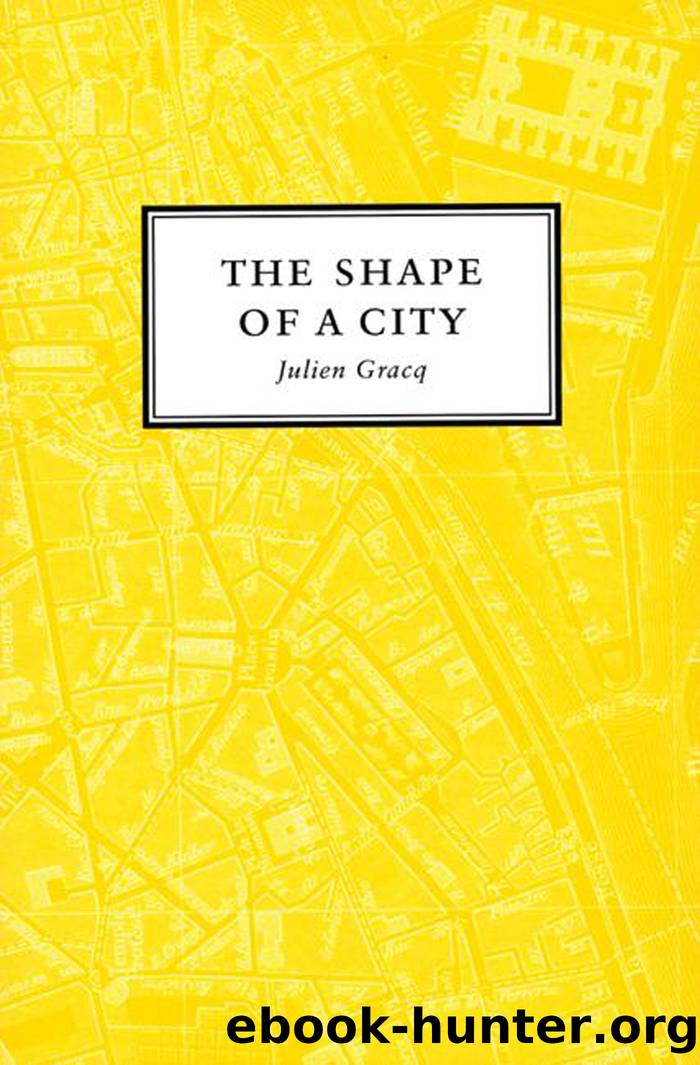The Shape of a City by Julien Gracq

Author:Julien Gracq [Gracq, Julien]
Language: eng
Format: epub
ISBN: 9781885586391
Publisher: Turtle Point Press
Published: 2020-09-15T00:00:00+00:00
* âI had not yet taken more than twenty steps while following the man who carried my suitcase when I realized that I was in a great cityâ (Stendhal, Souvenirs of a Tourist).
LOOKING AT MAPS OF A
cityâs agglomeration will confirm that the relationship of an estuary port with its river is rarely comparable to the axis of a geometric figure. Rouen and Bordeaux are not really firmly planted on the two river-banks from which they rose. Bordeauxâs crescent, whose inside curb follows the winding river, holds within its arc an urban agglomeration shaped like a shriveled up kidney, a sparsely developed annex located on the right bank which only stretches its tentacles along a starburst of roads. In Rouen, the river draws a rigid line of separation between the heart of the city and the outlying communities of Sotteville, a line cutting off the beautiful neighborhoods along the north bank from the south sideâs industrial commons, warehouses, polluting factories, and workersâ suburbs. During the war, after I had stepped off the bus at the terminal on the Seineâs south side and walked across the bridge, or while waiting, in the little smoke-filled station on the left bank in Saint-Sever, for that strange night train to Caen (a freight train with only one, unlit passenger car), I had the acute feeling of either leaving or re-entering a zone whose buildings are reserved for servantsâ entries and staircases. Nantes is no exception to the rule; worse yet, as already mentioned, the city in the past has never completely succeeded in leaving its mark on the south bankâat least not up to the time when, approximately thirty years ago, suburban housing developments began to take over neighboring rural zones. Furthermore, while crossing the city from upstream to downstream, there is a complete change of character in the river and its embankments; the Loire, which used to reach up into the cityâs heart with two of its northern eddies, found itself excluded, rejected by the landfills. There has not been, there could never be a divorce, but in a certain senseâa very sensitive point for those who knew Nantes âbeforeâ and âafterââa legal separation has taken place between the city and its river.
Sixty years ago, one would approach Nantes upstream from across vast stretches of vacant land: a continuation of the submersible prées (but much larger in size), those periodically inundated, unfenced terrains in the Loire Valley west of Angers, such as the prée of Anetz, used as a makeshift airfield by a Messerschmitt squadron in 1944; or the one at Rochefort where, on the rocky elevation point next to the road, a small monument commemorates several of aviationâs pioneers, René Gasnier among them, who made his debut here during the first years of the century. There once flowed an untouched, pristine river with nary a fisherman or a boat among these vast, empty grasslands fond of veiling themselves in wintry mists; land unprotected by dikes which sometimes would break up into islands, like the Héron or Beaulieu Island (in those times still quite deserted on the east side).
Download
This site does not store any files on its server. We only index and link to content provided by other sites. Please contact the content providers to delete copyright contents if any and email us, we'll remove relevant links or contents immediately.
Man-made Catastrophes and Risk Information Concealment by Dmitry Chernov & Didier Sornette(5921)
The Revenge of Geography: What the Map Tells Us About Coming Conflicts and the Battle Against Fate by Kaplan Robert D(4035)
Zero Waste Home by Bea Johnson(3780)
COSMOS by Carl Sagan(3554)
Good by S. Walden(3488)
In a Sunburned Country by Bill Bryson(3485)
The Fate of Rome: Climate, Disease, and the End of an Empire (The Princeton History of the Ancient World) by Kyle Harper(3003)
A Wilder Time by William E. Glassley(2818)
Camino Island by John Grisham(2762)
The Ogre by Doug Scott(2631)
Organic Mushroom Farming and Mycoremediation by Tradd Cotter(2626)
Human Dynamics Research in Smart and Connected Communities by Shih-Lung Shaw & Daniel Sui(2466)
Energy Myths and Realities by Vaclav Smil(2438)
The Traveler's Gift by Andy Andrews(2409)
9781803241661-PYTHON FOR ARCGIS PRO by Unknown(2323)
Inside the Middle East by Avi Melamed(2305)
Birds of New Guinea by Pratt Thane K.; Beehler Bruce M.; Anderton John C(2226)
A History of Warfare by John Keegan(2186)
And the Band Played On by Randy Shilts(2129)
